Big Herringbone Cowl
This winter New York City streets are filled with people who have learned the secret of keeping warm. They are all wrapped up in the big soft folds of the oversized cowl. A long loop that you twist and double around your neck, it’s definitely a glamorous touch in a what can otherwise be pretty frumpy season. Don’t you love when fashion and function meet in such happy harmony?

This cowl was inspired by Joelle’s classic Herringbone Poncho from her very first book, Last Minute Knitted Gifts. I have always been so taken with the drape and texture of Joelle’s poncho that I was really excited to borrow her idea for this project!
I stuck with Joelle’s choice of yarn, Blue Sky’s Worsted, because it is by far one of Purl Soho’s softest, most cuddly yarns, perfect for wearing around sensitive skin areas like your neck. A blend of fine merino wool and royal alpaca, it has a beautiful weight that creates cascading, dramatic fabrics. Just what I was looking for!
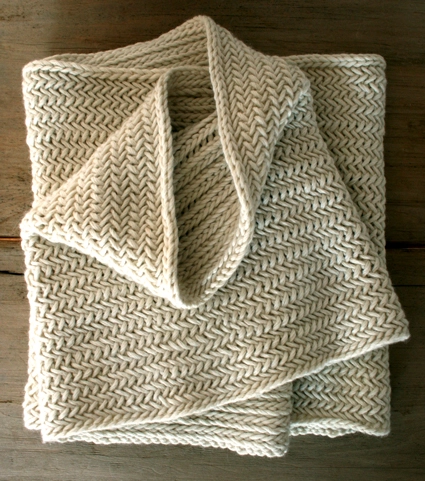
The cowl’s final look keeps one foot in the past with a traditional herringbone stitch. It’s such a distinctive stitch on such a powerful garment, you’re going to feel about one foot taller when you wear yours! -Whitney
Designed by Purl Soho designer, Whitney Van Nes.
Share your progress and connect with the community by tagging your pics with #PurlSoho, #PurlSohoBusyHands, and #PurlSohoBigHerringboneCowl. We can’t wait to see what you make!
Materials
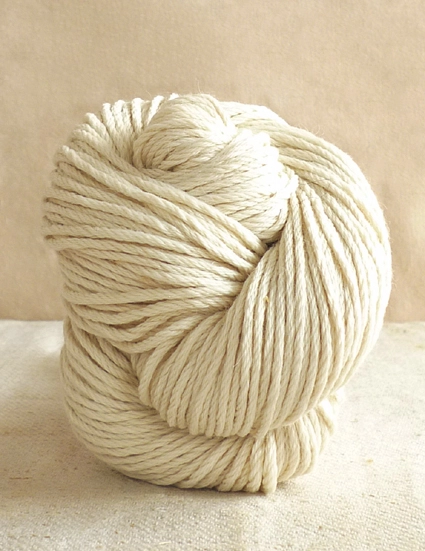
- 5 skeins of Blue Sky Alpaca’s Worsted, 50% Royal Alpaca and 50% Merino; or 500 yards of another worsted weight yarn. This color is “Ecru” #2003.
- A US 17 (12 mm), 32 inch circular needle
- A removable jumbo stitch marker
Gauge
15 stitches = 4 inches in herringbone stitch
Size
58 inches circumference x 14 inches high
NOTE
STITCH MULTIPLE
This pattern works over an even number of stitches.
Pattern
Cast on 220 stitches. We used a basic Long Tail Cast On.
NOTE: To ensure that your first round isn’t too difficult, cast on fairly loosely; your stitches should easily slide up and down the needle.
Join into the Round
Make sure the stitches aren’t twisted around the needle, and slip the last stitch you cast on from the right needle to the left needle (so that it is next to the first stitch cast on).
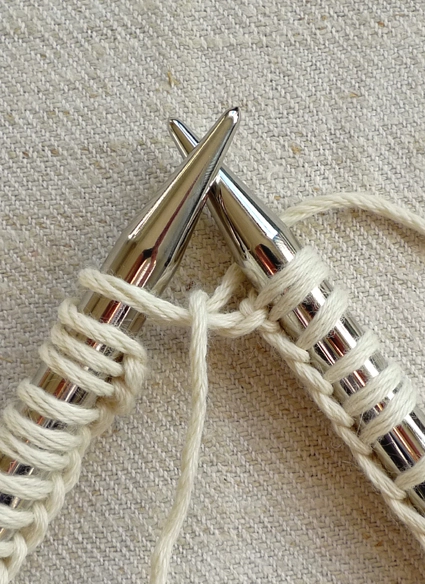
Place a removable jumbo stitch marker on the right needle.
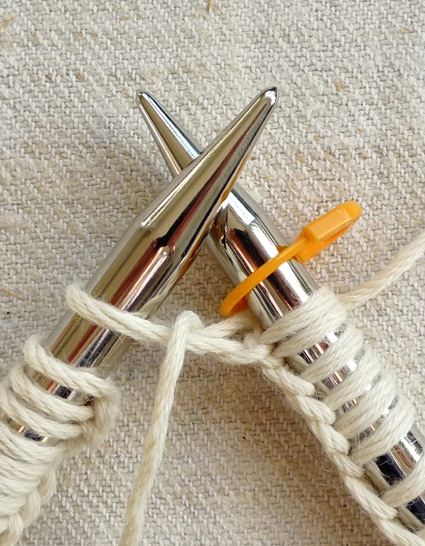
Knit two together (k2tog) and slip only the first stitch off the left needle (leaving the second stitch on the needle)…

…so it looks like this.
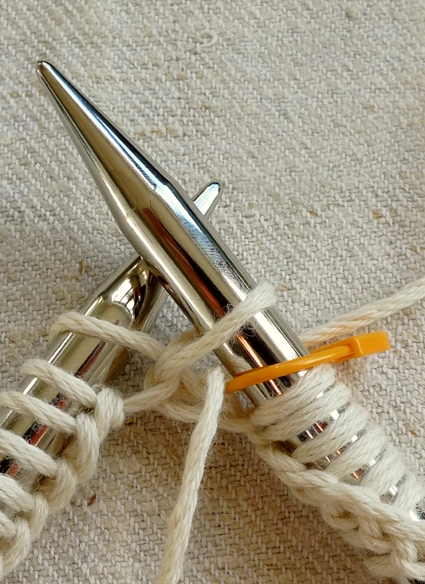
Continue
Round 1: *K2tog and slip only the first stitch off the left needle, repeat from * until 1 stitch remains.
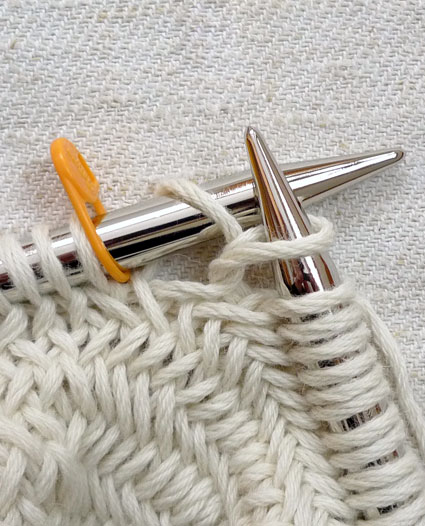
Remove the stitch marker and k2tog, slipping the first stitch off the left needle. Place the stitch marker to the right of the first stitch on the right needle.
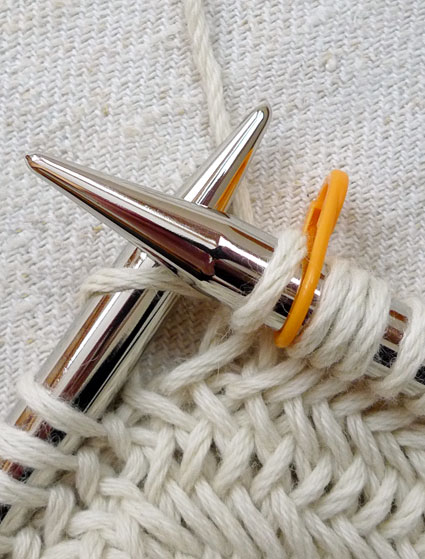
The next stitch looks like this…
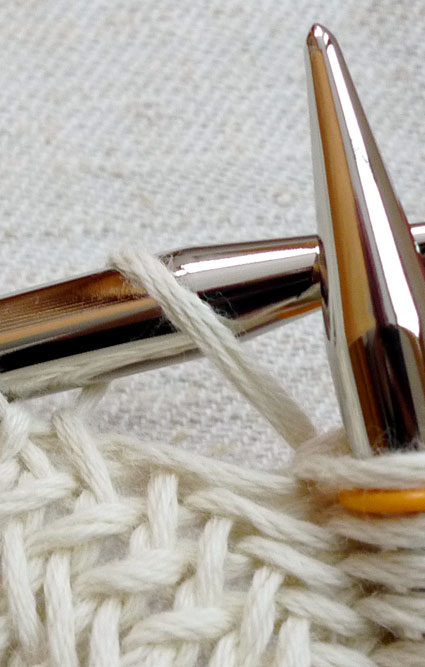
Remove that stitch from the needle, twist it, and place it back on the left needle so it looks like this…
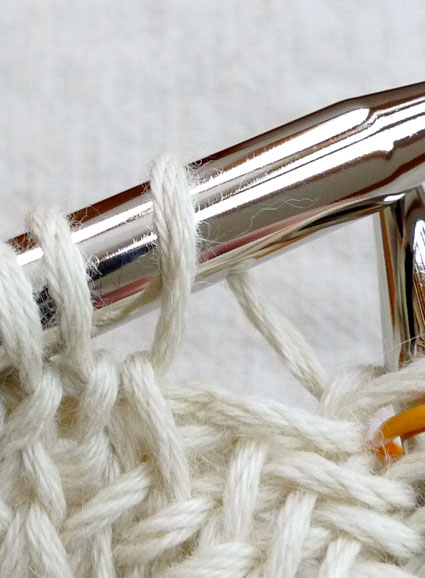
Round 2: *K2tog through the back loop (tbl), slipping the first stitch off the left needle, repeat from * to last stitch, remove stitch marker and k2tog tbl, slipping the first stitch off the left needle. Place the stitch marker to the right of the first stitch on the right needle.
The next stitch looks like this…
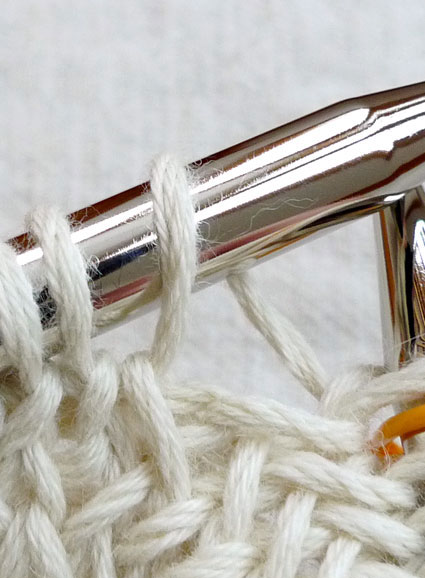
Remove that stitch from the needle, twist it, and place it back on the left needle so it looks like this…
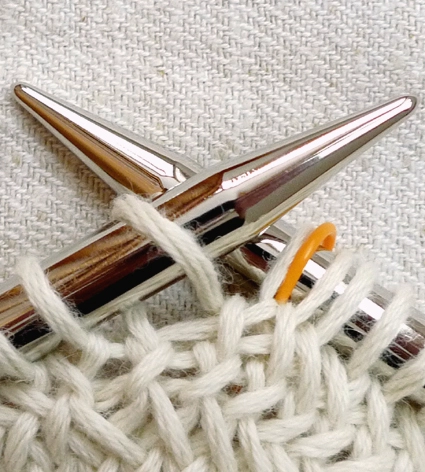
Repeat Rounds 1 and 2 until piece measures 14 inches from cast on edge, ending with all the steps of Round 2.
Here’s what the right side of Herringbone Stitch looks like:
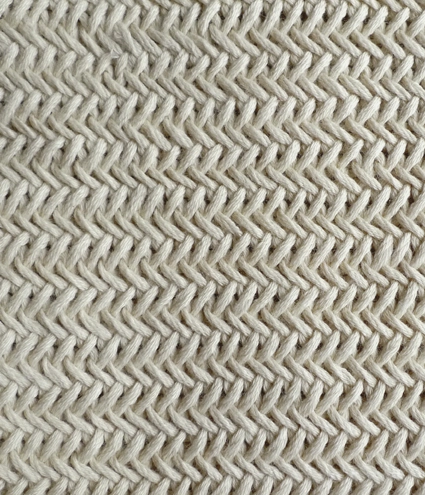
And here’s what the wrong side looks like:
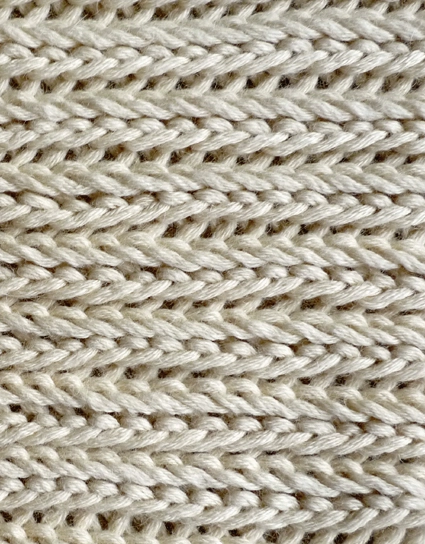
Bind Off
NOTE: You will continue to work Herringbone Stitch for the bind off.
Bind Off Round: [K2tog and slip first stitch off left needle] 2 times, pass first stitch over (just like a normal bind off), *k2tog and slip first stitch off left needle, pass first stitch over, repeat from * until 2 stitches remain (1 stitch on the left needle and 1 stitch on the right needle), knit last stitch tbl and pass first stitch over.
Weave in the ends, gently block and then bundle up!
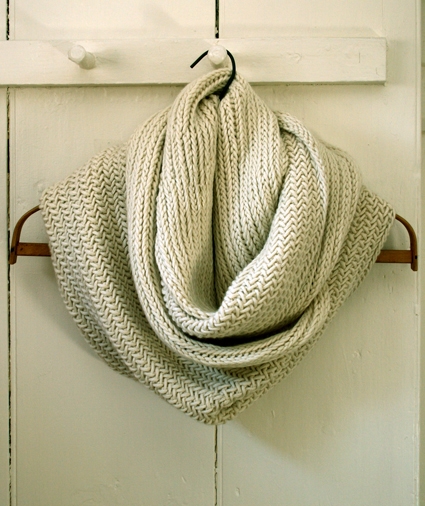

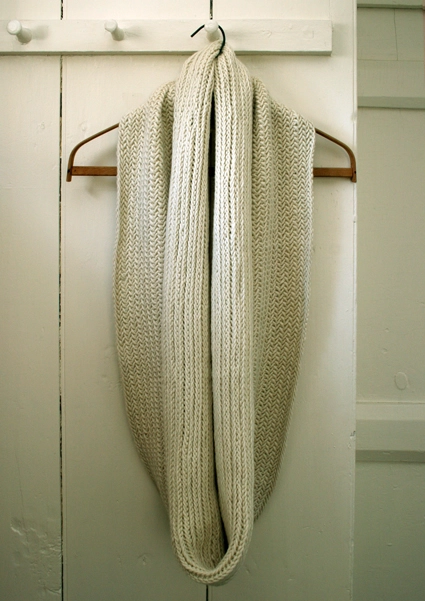

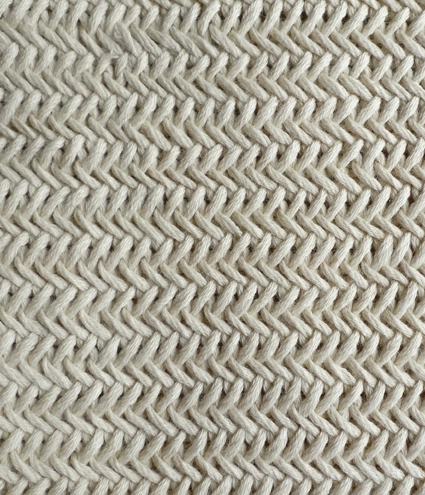

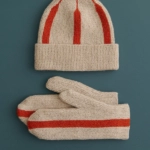

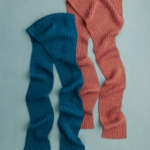

Hello!
Thank you for this pattern, I’ve made two of this so far – the first one was a bit short because I’m a tight knitter so for the second one I decided to go several stitches more but then it ended up too long! I would like to unravel the whole project to start again, but I’m finding that the herringbone stitch doesn’t unravel as simply and quickly as a normal garter or stockinette stitch. Do you have any recommendations/tutorials on how to quickly unravel this particular stitch?
Thanks!
Hi Pia,
Thanks for writing in! I just did a test swatch and the herringbone stitch shouldn’t be too much more difficult to unravel than a plainer stitch. Is it possible that you used a textured or fuzzy yarn that is sticking to itself? This is a common problem, especially when using yarn that has a halo such as mohair or certain alpacas. If that is the case, it may help to put your project in the freezer for an hour or so before unraveling – when the fibers are cold they separate much more easily!
Best of luck and happy unraveling – and re-knitting!
Julianna
I loooove the look of this herringbone stitch. I am also in love with chenille yarn. Do you think that chenille yarn would show the definition in the herringbone pattern?
Thank you
Hi Nancy,
Thanks for the kind words! Chenille yarn does tend to blend together when knitted and can disguise intricate stitch patterns, but how much the stitch will show up depends on how thick or fluffy the chenille is. The best way to find out would be to knit a swatch with your chenille yarn to see if you are happy with the stitch and yarn combination!
I hope that helps!
Julianna
Would love to do this for a male friend but needs to be short to just cover the neck area. How is the stitch count for that to happen. Thanks
Hello Enid,
Thank you for reaching out! For this scarf we got a gauge of 15 stitches per 4 inches in herringbone stitch. I would reccomend checking out our Men’s Mini Herringbone Scarf. I think it might be just what you are looking for!
Happy knitting,
Marilla
Can this pattern be done on any even number of stitches? I’m using just a tiny bit smaller gauge and want to cast on a higher number of stitches to account for the change in size.
Thanks
Hello Alex,
Thank you for reaching out! Any number of stitches work for this cowl in the round, so you can cast on an even or an odd number.
Happy knitting!
-Marilla
Can this pattern be done with a cast on of any even number? I’m looking to use a bit smaller gauge, and increase the number of cast on stitches, but want to make sure odds or evens don’t matter.
Thanks
Hello Alex,
Thank you for reaching out! You are correct, you can cast on any number of stitches for this pattern in the round.
Happy knitting!
-Marilla
Re Big Herringbone Cowl, could I use your cashmere/merino mix (bulky, I think). If not, what yarn would you suggest?
The worsted mentioned in the pattern appears to be no longer sold.
Thank you.
Hello Carole,
Thank you for reaching out! The yarn we used if Blue Sky’s Worsted which works great for this pattern as it has fantastic stitch definition. Our Cashmere Merino Bloom is a DK weight yarn so it would be thinner than what we used for this pattern.
I hope this helps and happy knitting!
-Marilla
Would a bulky yarn work for a shorter cowl (wraps around the neck once) or scarf? Could I use gentle giant or is that too bulky?
Hi Dana,
Thanks for reaching out! While it is possible to modify this pattern for super bulky Gentle Giant, due to the fact that the Herringbone Stitch requires a much larger needle than normally recommended for the yarn, I think you would have to go up to a US 50 needle. It would certainly be quite a statement piece! Even going up to a bulky yarn, such as Super Soft Merino, I would suggest trying a US 35 needle. Whichever yarn you choose, I would suggest working a gauge swatch in pattern to determine if the needle size is suitable and to measure your stitches per inch.
I hope that helps!
Julianna
I wonder if I can make this using understory .. I have two balls left over from a previous project.. Would I go down to a size 15 needle? Thanks
Hi Emily,
Thanks for reaching out! I think this stitch would be just lovely in Understory! Although it is a touch thinner than the Blue Sky Worsted we originally used for this pattern, I don’t think it is enough to change the gauge significantly. It would probably be a good idea to knit a gauge swatch to make sure, but I think Understory will still look great on US 17 needles in the herringbone stitch.
Happy knitting, and please let us know how the cowl turns out!
Julianna
I love the herringbone stitch and have been wanting to make a fringed blanket with it for so long! Do you think one could use this pattern and just increase the number of stitches cast on and the width? And if so, would this yarn and needle size make a blanket too thin? Thank you!
Hello Danette,
Thank you for reaching out! This is a great idea, we even have a tutorial for knitting this stitch flat. I would just knit up a gauge swatch with your yarn and once you decide how big you would like your blanket to be you can use your swatch to figure out your cast on number.
Happy knitting,
Marilla
I saw someone did this in Malabrigo Rios yarn . How would I adapt ?
Thankyou !
Hello Beth,
Thank you for reaching out. I believe Malabrigo Rios is a worsted yarn. As long as you are on gauge, you shouldn’t need to adapt at all!
Happy knitting,
Marilla
I vought some Mulberry Merino (3 skeins), do you think they are enough for a cowl? I love how this looks!
Hello Irene,
Thank you for reaching out! Since your yarn is a sport/dk rather than a worsted weight it will be best to go down to at least a US 13. I would make a swatch to see if you liked the texture with that size. Once you figure out the gauge, then you can multiply by 58″ around.
That being said, you can definitely chose not to cast on more stitches since this cowl is written very over-sized. Many people in fact prefer to make this cowl a little smaller, like around 50″ around. Please don’t hesitate to write in again if you have any other issues!
Happy knitting!
-Marilla
I would like to make this for someone who is allergic to wool (can’t wear any). What yarn would you recommend and what modifications would I need to make to the pattern to achieve the same results.
Thanks
Joyce
Hi Joyce,
Great question! Blue Sky Worsted Cotton would be a perfect wool-free substitute, and you would not have to make any changes to the pattern since it is the same weight as Blue Sky Worsted Hand Dyes. Also, since it has more yardage, you will only need four skeins.
Happy knitting!
Julianna
I like this sideways cowl compared to the mini-herringbone scarf but would like to use Linen Quill. Can you suggest a cast on number and needle size for a 50″ cowl, please?
Hi and thanks for writing in! I would suggest knitting a gauge swatch in the herringbone pattern using Linen Quill on a US 9 or 10 needle. Once you are happy with the density and feel of the knitted fabric, you can measure your gauge swatch and multiply your stitches per inch by 50 and round to the nearest even number to figure out your cast on number.
Best of luck and happy knitting!
Julianna
I am swatching for this right now?. I do have a question about the guage. The 15 stitches to 4 inches, is that blocked or un-blocked? Thank you for such a wonderful pattern.
Hello Nikki,
Thank you for your question! I would reccomend blocking your gauge, because you want your gauge to be as close to the end result as possible.
Happy knitting!
-Marilla
I cast on 220 stitches, as the pattern calls for. After knitting 4 rows, I counted and found my stitch count is now 219. I can’t seem to spot an error. Does the stitch count always remain 220, or does it vary? Thanks!
Hello Rachel,
Thank you for writing! Your stitch count should remain consistent throughout.
I hope this helps and let us know if any more questions come up!
-Marilla
I’m a fairly new knitter, do you have a video that demonstrates this knitting technique or have one you could recommend? There seem to be a few ways of doing the herringbone stitch but I seem to learn best by watching videos. So far I’ve only knitted and purled but I’m hoping this isn’t too ambitious for my next project! Thanks! 🙂
Hello Meagan,
Thank you for reaching out! We don’t have a video Tutorial for this stitch. I would reccomend practicing the stitch on a swatch before jumping into your project so that you feel confident going in.
Let us know how it goes and happy knitting!
-Marilla
I’ve made a start on the project now and I have another question, I’ve finished row 1 and turned the stitch at the end, now I’m part way through row 2, what do I do at the end of row 2, do I just keep doing the same stitch til I reach the stitch marker then begin row 1 again, or do I turn the stitch again? Thanks, I’m really enjoying the pattern so far!
Hello Meagan,
Thank you for reaching out! For round 2 you will *K2tog through the back loop (K2tog tbl), slipping the first stitch off the left needle, repeat from * to the LAST stitch. Remove the stitch marker and k2tog tbl, slipping the first stitch off the left needle. Place the stitch marker to the right of the first stitch on the right needle.
I hope this helps and happy knitting!
-Marilla
–
Hi! I am attempting this stitch, but worry I am making a mistake at the beginning or end of each round. Is this a seamless project? Will I be able to see where the rounds begin and end? It’s almost like the herringbone is spiraling—the end of a right facing stitch becomes the beginning of a left facing stitch. Does that sound right?
I love the pattern! And am making a super short cowl, more like a gaiter. Maybe it’s more prominent on the smaller scale but I made me worry I am doing something wrong! Thank you!!
Hi Madison,
Thanks for writing in! This lovely pattern is not truly seamless. The end of each round will be visible as the stitches switch direction. When worn, you will not really see this beginning/end of round but it will be present!
I hope that this helps!
Cassy
I love this pattern and want to try it with bulkier yarn. What would you recommend for us 36 needles? Also should I stay with the 32 inch cord or size up as well?
Hi Kara,
Thanks so much for the kind words! On a US 36 needle, I would suggest using a bulky yarn like Super Soft Merino. You should still be able to fit all the stitches on a 32 inch long needle, but it would probably be a good idea to knit a gauge swatch to see if you need to adjust the cast on so you don’t end up with a cowl that is too long!
Happy knitting!
Julianna
I am just learning this stitch, and I am an intermediate- beginner knitter. I’m confused about turning the stitch.
Is that for every stitch in the second row?
The stitch bible I have says to p2tog, dropping off the first stitch for row 2. I understand there are different ways to make this, but again, do we twist every stitch?
I also see no purling here.
Thank you,
Jana
Hi Jana,
Thanks for reaching out! You only have to turn the first stitch of each row – the rest of the stitches can be worked without turning. It sounds like your stitch bible has a version of this stitch which is worked flat, rather than in the round like our cowl, which is the reason both for the lack of purls and for turning the first stitch of each round.
I hope that clears things up!
Julianna
Hi,
I wanted to size this up to US36 needles. What size yarn/ how many cast on stitches would you recommend?
Thanks,
Kara
Hi Kara,
Thanks for writing in! I would suggest using a bulky weight yarn, like Super Soft Merino, on US 36 needles. To determine how many stitches to cast on, you will need to knit a gauge swatch in pattern using your chosen yarn and needles and then measure your stitches per inch. You can multiply then this by 58 inches and round to the nearest even number.
Best of luck and happy knitting!
Julianna
I’ve copied this pattern using different wool and I’ve used the needles that the wool recommends however it is now curling up. Will blocking this fix that? I’m already two balls of wool into the project so unravelling it is not really an option
Hello Stephanie,
Thank you for reaching out! Your gauge might be to tight, this stitch requires that you use a much larger needle than what you would use for a stockinette or garter stitch. We used a worsted weight yarn which recommends a US 9 needle, but for this stitch we used a US17 needle.
I hope this makes sense and let us know if this answers your question!
-Marilla
Hello,
I loved this pattern the first time I saw, and am thinking of using an aran acrylic mix for this project. Given I’m fairly new to knitting, I don’t have many tools and am wondering how might the look/stitch definition change if I used a US #15 needle instead of #17? I wouldn’t mind a tighter knit but I’m unsure if there may be other structural issues that might happen eg. curling. (the yarn mix is 74% Acrylic 20% Wool 6% Viscose, if it’s a consideration) What would you recommend?
Thanks,
Esther
Hi Esther,
Thanks for writing in! While this stitch does not tend to curl up, you will end up with a smaller cowl and the fabric may end up stiffer and have less drape than our cowl, depending on how tight it turns out. The only way to tell for sure how it will behave would be to knit a swatch in pattern and decide if you are happy with your yarn on a US 15!
I hope that helps, and happy knitting!
Julianna
I love this pattern and would like to use a yarn that is similar in weight to get the same result, because the worsted hand dyes are discontinued. What yarn would you recommend?
Hi Mimi,
Thanks for reaching out! I would suggest substituting Understory, Worsted Twist, Madelinetosh Tosh Merino, or Manos del Uruguay Maxima, but you can use almost any worsted weight yarn for this cowl!
Happy knitting!
Julianna
Hi! What other yarns would you recommend for this pattern since the Blue Sky is no longer available?
Hi Joanna,
Thanks for reaching out! I would suggest substituting Understory, Worsted Twist, Madelinetosh Tosh Merino, or Manos del Uruguay Maxima, but you can use almost any worsted weight yarn for this cowl!
Best,
Julianna
Hi Julianna!
Just to confirm, any of these yarns would also be on the US 17 needles, and would also require 5 skeins?
Thank you!
Hi Samantha,
Yes, that is correct! The herringbone stitch results in a very desnse, compact fabric, so when using a worsted weight yarn, we bumped the needle size up to a US 17 to lighten things up!
Best,
Julianna
Hi, can you tell me how many grams or yards are in a skein? I usually buy wool in 100 gram balls so not sure how many I would need to get.
Thanks
Audrey
Hi Audrey,
Thanks for writing in! This yarn had 100 yards per 100 gram skein, and we used 5 for this cowl. Since yardage is usually much more accurate than grams, I would recommend checking the label of your yarn to make sure you have at least 500 yards of yarn.
Best,
Julianna
Does the stitch marker keep moving to the right or should it always be in the same place? It seems my stitch marker keeps moving away from the beginning of the first round.
Hello Candice,
Thank you for reaching out! In this pattern you will remove the stitch marker and k2tog, slipping the first stitch off the left needle. Place the stitch marker to the right of the first stitch on the right needle. To keep your marker in place you must do these steps every time you end/begin your round.
I hope this helps and happy knitting!
-Marilla
Is there a reason this pattern rolls significantly, but the mini herringbone doesn’t? I noticed this is recommended for knitting in the round, but the other pattern is used for a flat knit – why is that? I want to use this pattern for a blanket so it needs to stay flat. Would blocking or a much bigger needle (I’m using 15) help? I don’t want to finish blocking and risk it never staying flat given how much yarn is needed.
Hi Olivia,
Thanks for reaching out! Although the finished products look quite similar, the stitch used for the Big Herringbone Cowl and Mini Herringbone Scarf are worked differently, and as a result the Mini Herringbone Scarf stitch lays flat and is better suited for items that won’t be in the round. A very loose gauge does reduce rolling, so you could try a larger needle, but also, we don’t have instructions for knitting this version of the herringone stitch flat, so I would recommend using the version we used for the scarf instead for your blanket.
I hope that helps, and happy knitting!
Julianna
Why is the needle so large? Is it to accomodate the herringbone stitch? Is the yarn held double?
Hi Deborah,
Great question! Due to the nature of this herringbone stitch, it creates a very dense, tightly knit fabric, so it looks best if you knit it on a much larger needle than you normally would for the yarn. You will be using your yarn held single.
Happy knitting!
Julianna
I am knitting the cowl in herringbone stich but have made an error. How do I unravel the stitch (or stitches) so that I can continue. Is there a video which would show how to unravel this stitch?
Hi Nancy,
Thanks for reaching out! Unfortunately we do not have a video showing how to fix mistakes in this pattern, but you are correct that it can be quite tricky! We recommend taking your time and tinking, or taking out your stitches one at a time, until you get back to your error.
Best,
Julianna
Hello, I have started this several times and ripped out. I find that if I drop a stitch I am completely lost. I am an experienced knitter and can always fix mistakes in normal knitting but this one has me completely stumped. I am highly motivated because I love the stitch but man, one false move and I’m ripping out again. It all seems so simple, but it’s not.
Hi Bev,
Thanks for reaching out! That is very true… This stitch requires a lot of concentration since it is pretty difficult to fix mistakes! Taking your time and working slow to avoid any mistakes is the way to go!
Happy knitting!
Gianna
Hi! I want to make this is the Worsted Twist. According to your product details, 3 skeins will provide 492 yards. The pattern calls for 500 yards. Will 3 skeins work? Thank you!
Hi Linda,
Thanks for reaching out! Although you might have to cast off a row or two sooner than we did, I think your cowl will turn out great with three skeins of Worsted Twist! I would recommend knitting the pattern until you have about 5 yards of yarn left. That should be enough to cast off!
Happy knitting!
Julianna
Do you have to cast on to the right needle to start this cowl?
Hi Ruth,
Thanks for reaching out! For this cowl, you will cast on just as you normally would, using the same size needle that you will for the rest of the cowl.
I hope that clears things up!
Julianna
I have this same question. I am trying this pattern for the first time, and I just finished casting on 220 stitches…onto the left needle. I read the next step, and it seems like the pattern is written to cast on to the right needle. I’m thinking it should work if I just do everything opposite (as far as left and right are concerned) for the rest of the time. Do you agree?
I’m left handed, and I’ve ended up doing this with many knitting/crochet patterns over the years when I accidentally do things opposite the pattern.
Hi Britni,
Thanks for reaching out! Since you are casting on the 220 stitches onto circular needles and joining the work in the round you should be goo to have them on the left or right needle!
All the best,
Gianna
Hello,
Beautiful cowl!
Could you please advise us on which cast on method was used for this project?
Thanks
Hi Joey,
Thanks for reaching out! Basic Long Tail Cast On should be fine for this pattern!
Warmly,
Gianna
I’ve made this cowl in the past and was looking to make it again…which yarn would you suggest since the original one is unavailable? thank you!
Hi Lauren,
Thanks for reaching out! You could use any worsted weight for this pattern! I would suggest our Worsted Twist or Linen Quill Worsted!
Warmly,
Gianna
I am on my second cowl. I have discovered by accident that it’s far easier to rip out rows than to try to fix a mistake in a row. It was easy to get all the stitches back on the needles after ripping out a row or two. Saved me starting over again and again. Hope this saves someone else.
Help! I tried to cast on as loosely as possible but my stitches seem too tight to do the first row and get tighter with each stitch. What do I need to do? Thanks, I’m drooling over this pattern ❤️.
Hi Linda,
Thanks for reaching out! I am happy to help! When you fist cast on did the stitches move easily along the needle? and what method of cast on did you use?
Looking forward to your response!
Warmly,
Gianna
I would like to try to use this pattern for simple cowl in the round using lace qiviut and silk blend. I would normally knit with size 00 and still get loose airy fabric from this yarn. What size needles would you recommend I try?
Hi Irena,
Thanks for reaching out! Using a US 00 needle would be a much different gauge than the written gauge of the pattern (since we used a US 17!) If you wanted to have a very fine version of the pattern than I would suggest working a gauge swatch first so you can adjust the pattern from there! As I am not familiar with the lace qiviut and silk blend yarn I can’t recommend a needle size. The yarn should have a suggest needle size with it and for this stitch I would recommend sizing up a need or 2 from what they recommend.
I hope this helps, happy knitting!
Gianna
Hi! I really would like to make this cowl, but many of the desired colors in the Worsted Twist are sold out. Is your Linen Quill Worsted as warm? Is there any other yarn that would work for this pattern that is soft and warm? Thank you!
Hi Lauren,
Thanks for reaching out! The Linen Quill Worsted would be a great alternative yarn to use in place of the Worsted Twist! It’s very warm and the linen content gives it some wonderful texture. If you want an option without the linen, which can sometimes be a little bit scratchy, I’d suggest either Anzula’s For Better or Worsted or Woolfolk’s Far as warm (and very soft) alternatives!
I hope this helps!
Take care,
Kelsey
Thank you so much! This is very helpful. Would it be the same needle size? (I know I need to do a gauge swatch, but I’m wondering what size needles to get.) And the same number of skeins?
Thank you!
Hi Lauren,
You should be able to use the same needle size with the other worsted options! They’re all similar in gauge to the Worsted Twist, though as you said I would recommend working up a gauge swatch first. I’d start with the US17’s and go from there. The Herringbone stitch works better if you’re using a larger needle; the stitches can get too tight if you size down too far!
I hope this helps, but please let me know if you have any other questions!
Happy Knitting!
Kelsey
Thank you so much!
I love love love this pattern! Thanks for sharing it. However I’m having a major problem with rolling on the edges. What did I do wrong?
Hi MJ,
Thanks for reaching out! Rolling can happen, and it can also be easily fixed! Blocking your finished cowl should help eliminate rolling!
Warmly,
Gianna
Oh – also, is it the same number of skeins if I use Woolfolk’s Far?
Hi Lauren,
I did some investigating and the original yarn used was 110 yards. The pattern calls for 5 skeins, so you’d need about 550 yards total for the project. With that in mind, I’d recommend buying 4 skeins of the Woolfolk Far, to make sure that you’ll have enough!
I hope this helps!
Happy Knitting!
Kelsey
What would you suggest for a yarn that is comparable to what this pattern the big herringbone cowl blue sky alpaca is calling for? I cannot locate the exact yarn the pattern is calling for please provide me your thoughts. Much appreciated
Hi Deborah,
Thanks for reaching out! Unfortunately, we no longer carry this yarn, but luckily any worsted weight yarn will be great with this pattern! I would recommend using our lovely Worsted Twist!
I hope this helps and please let me know if you have any more questions!
Gianna
Hello, Gianna…
I would like to make this as a regular-sized cowl closer to the neck. Do the number of stitches matter with this pattern, or can you have as many stitches as you want, or don’t want?
Thank you!
~Carol
Hi Carol,
Thanks for reaching out! You can cast on as many stitches as you would like, as long as it is an even number!
Warmly,
Gianna
This helps greatly, Thank you so much!!
Have a lovely weekend… :o)
Do I use the herrinbone stitch when knitting the swatch on circular needles? I am a beginner by the way.
Hi Diane,
Thanks for writing in! Yes, that is correct! For the swatch, you will want to use the herringbone stitch and make a swatch in the round. Typically when I am swatching in the round, I will make a swatch that is 5 inches wide (10 inches in circumference) and I will use either double pointed needles or Magic Loop! You can also check out our wonderful tutorial Swatching For Circular Gauge!
I hope this helps, happy knitting!
Gianna
I am finally knitting this after ogling it for many years, and it has been an absolute pleasure. Apart from binding off, that is – I have bound off and ripped out twice because I can’t seem to do it without loose sloppy loops popping up periodically. Before I start again, do you have any advice that will make the third time be the charm?
Hi Tanya,
Thanks for reaching out, although I’m sorry to hear that the bind-off for this pattern is giving you trouble! Would you be able to send a photo of your work to customerservice@purlsoho.com? That way, we’d be able to visualize the problem better and troubleshoot from there!
All the best,
Lili
Thank you so much – I will do that right now
Hi! I love this cowl and wear the one I made everyday during the winter. I am making another one now for my sister- I never blocked mine but would like to do it for both mine and hers. What’s the best way to block this? Thank you!
Hi Lauren,
I would recommend wet blocking the cowl and laying it flat to dry! Our How To Hand Wash A Sweater tutorial actually provides some great tips, since it’s geared towards larger sized projects.
All the best,
Lili
Thank you!
How do you count stitches for gauge in the herringbone pattern?
Hi Bonnie,
That’s a great question! For stitch patterns like herringbone, where the individual stitches are obscured, I’d actually recommend measuring your gauge in an opposite way from normal. Just cast on the number of stitches that the stitch gauge indicates (in this case, 15 stitches), and then work in pattern for a bit (this pattern doesn’t specify a row/round gauge, but for patterns with a row/round gauge, you would want to knit the exact number of rows/rounds specified). Then, measure the width (and length, if your pattern has a row/round gauge) of the swatch. If it’s 4 inches, then you’re on gauge! If it’s more than 4 inches, you would need to try smaller needles, and if it’s less than 4 inches, you’d need to try larger needles.
Hope this helps!
All the best,
Lili
I have made a mistake and need to tink a k2tog stitch. All the directions I found show how to tink a k2tog decrease. Would it be the same steps even though nothing is being decreased? Thank you so much!
Hi Jennifer,
Thanks for reaching out! The easiest way to tink one of the k2tog stitches in this pattern would be to first drop the second stitch off the left needle. This will turn the k2tog into a normal k2tog, and you can tink it as you would any other k2tog. Hope this helps!
All the best,
Lili
Hi!
My version of this cowl (in malabrigo rios) continues to curl even after some serious blocking. And I means serious blocking. I blocked the hell out of it. I would love to make another one, but how do I prevent the curling? On Ravelry it is suggested to cast on and knit the first rounds on smaller needles, but the fabric still curls…
Any suggestions would be incredibly appreciated!
Hi Anna,
I’m so sorry to hear that your cowl is curling so much, even after blocking! You could try adding more of a border in a non-curling stitch, such as garter or ribbing. This will essentially hold the edges down and prevent the entire knit fabric from curling!
All the best,
Lili
Thank you so much for replying! I really appreciate it. I’ll give the ribbing a shot. 🙂
I made this cowl back in 2014, and I love it. A friend recently asked if I could make her one. Blue Sky Fibers Worsted Hand Dyes is no longer available. Can you recommend a replacement yarn? Thanks!
Hi Joan,
Thank you for writing in! We are thrilled to hear you will be making a scarf for your friend! We would recommend Yonder or Hedgerow as great alternatives for this pattern. I hope this helps but please let me know if you have any questions!
Happy knitting,
Gavriella